Full Sun Evergreen Shrubs – Identification Guide
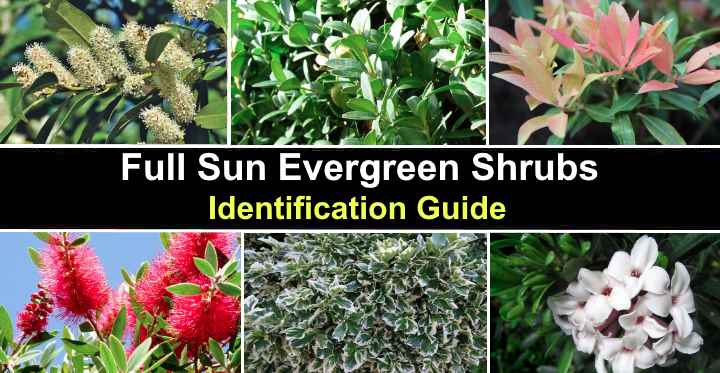
Full-sun evergreen shrubs enhance outdoor spaces with year-round foliage. They come in small and large bushy varieties, ensuring a lush garden landscape. Evergreen shrubs add texture to sunny gardens with diverse shapes, sizes, and colors. From compact conifers to flowering multi-stemmed plants, sun loving evergreen shrubs thrive in 6-8 hours of sunlight, making them essential for sunny yards.
This article highlights the best full-sun evergreen shrubs for your garden landscape. Descriptions and pictures of sun-loving shrubs with year-round foliage and flowers will help you choose the best plants to add vibrant colors to your yard.
What Does Full Sun Mean?
In botanical terms, full sun refers to plants that grow in direct sunlight for most of the day. Full sun evergreen shrubs typically perform best with six to eight hours of sunshine. You can plant them in the sunniest part of your garden landscape.
How to Choose Evergreen Shrubs for Full Sun
It’s vital to consider several factors when choosing evergreen shrubs to plant in direct sunlight. These factors include USDA hardiness zones, soil type, drainage, and tolerance to drought. Also, think about the shrub’s mature size so that it complements your landscape and reduces the need for pruning.
Full Sun Evergreen Shrubs (With Pictures)
Here are some of the best full sun evergreen shrubs.
Sweet Bay Magnolia (Magnolia virginiana)
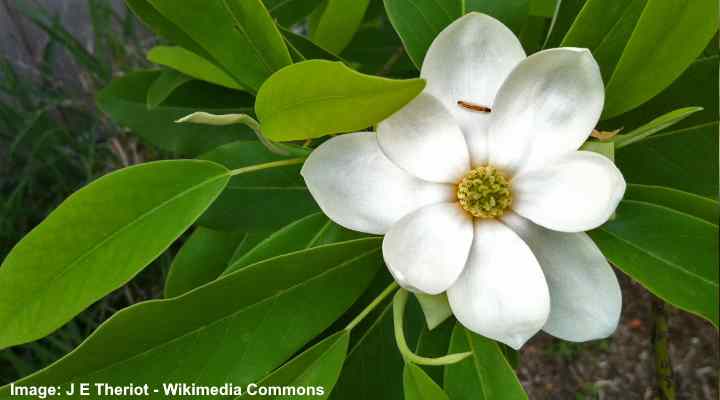
Sweet bay magnolia is an evergreen sun-loving shrub or small tree with scented white cup-shaped flowers
Sweet bay magnolia is a sun-loving, evergreen multi-stemmed shrub with fragrant white flowers and glossy foliage. Blooming in spring and summer, the sweet-scented blossoms measure 2” to 3” (5 – 7.5 cm) across and have a lemony fragrance. The shrub’s glossy green lanceolate leaves have a silvery underside and form an attractive rounded shape, giving the plant an elegant appearance.
Sweet bay magnolia grows 10 to 35 ft. (3 – 10.5 m) tall and wide. Flowering occurs best in full sun; however, the evergreen shrub performs well in partial shade. This evergreen magnolia is ideal as a specimen plant, hedge for privacy, or foundation planting. The plant prefers slightly acidic, well-drained, consistently damp, or wet soil.
Sweet bay magnolia is suitable for growing in USDA zones 5 through 10.
Evergreen Encore Azalea Shrubs (Rhododendron)
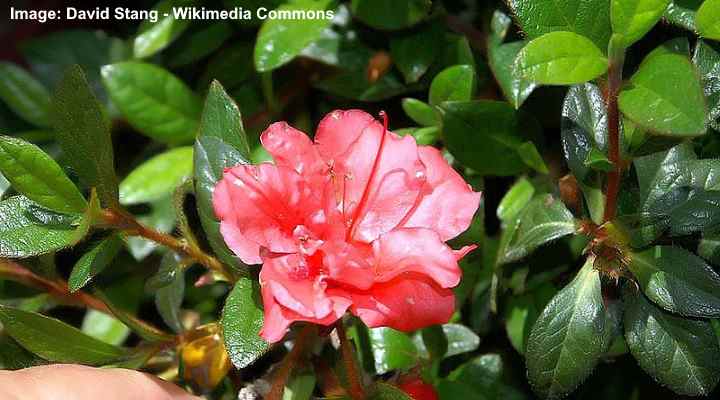
Azalea encore ‘Autumn Princess’ (in the picture) is a small evergreen heat tolerant shrub with stunning ruffled flowers for full sun or partial shade
Evergreen Encore azalea shrubs are popular for sunny gardens because of their evergreen foliage and multiple blooming times throughout the year. These small shrubs produce large, showy flowers in a variety of colors—shades of pink, red, white, and purple. The evergreen foliage provides year-round interest and adds a pop of color to sunbaked landscapes.
Evergreen shrubs in the Encore range typically grow 2 to 3 ft. (0.6 – 1 m) tall and wide. The shrubs are covered in trumpet-shaped flowers from spring through fall. Azalea shrubs are ideal for foundation plantings, mixed borders, or as an evergreen hedge. They also make excellent container plants for patios and decks.
Evergreen Encore Azalea shrubs are suitable for growing in USDA zones 6 through 10. They require well-drained soil, regular watering, and plenty of sunshine to perform best.
Boxwood (Buxus)
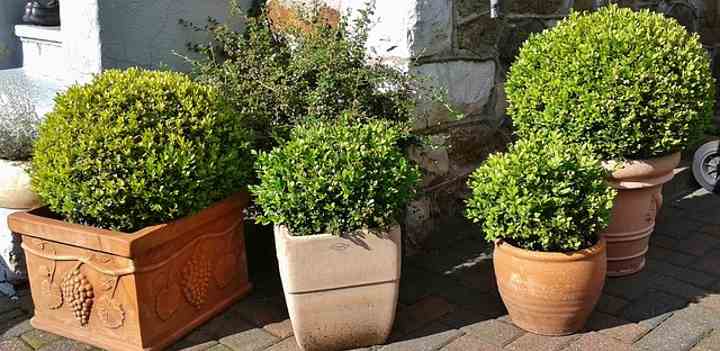
Place small evergreen boxwood shrubs in sunny areas of your garden as a decorative element in your front or backyard
Boxwood is a group of versatile, evergreen shrubs perfect for sun-drenched gardens. The shrubs have small, oval leaves and a dense growth habit. Boxwood shrubs are extremely low maintenance and ideal for formal landscapes, shaping into hedges, topiaries, or small ornamental trees. The evergreen shrubs have a rounded or pyramidal shape.
Boxwood shrubs are a popular landscape option for full sun or shade gardens. Their lush, evergreen foliage retains the deep green color throughout the year.
You can plant boxwood shrubs in containers, beds, borders, or along a foundation line. Additionally, tall, slender boxwood shrubs can be strategically placed in the landscape as accent plants. Or you can plant the shrubs in a row to create a privacy screen.
Boxwood shrubs are suitable for growing in USDA zones 5 to 9.
Wintercreeper (Euonymus fortunei)

The colorful foliage of small evergreen Euonymus shrubs add an ornamental element to any garden. This picture shows the compact cultivars: ‘Emerald ‘n’ Gold’, ‘Emerald Gaiety’ and ‘Moonshadow’
Wintercreeper is a versatile low-growing evergreen shrub you can use as ground cover in full sun. The eye-catching feature of wintercreeper is its dark green glossy leaves. Depending on the cultivar, the foliage can also have variegated leaves in green and creamy-white or green and golden yellow. Red berries appear in the fall.
Wintercreeper is a vigorous shrub, ideal for the sunniest spots in your yard. This low-maintenance shrub performs well as ground cover, erosion control on slopes, or incorporated into borders or mixed plantings. You can also grow it as a fast-growing climbing vine to cover a trellis, wall, or unsightly fence.
Wintercreeper is suitable for growing in USDA zones 5 to 9. However, it’s not native to North America and can become invasive in some areas.
Bird’s Nest Spruce (Picea Abies ‘Nidiformis’)
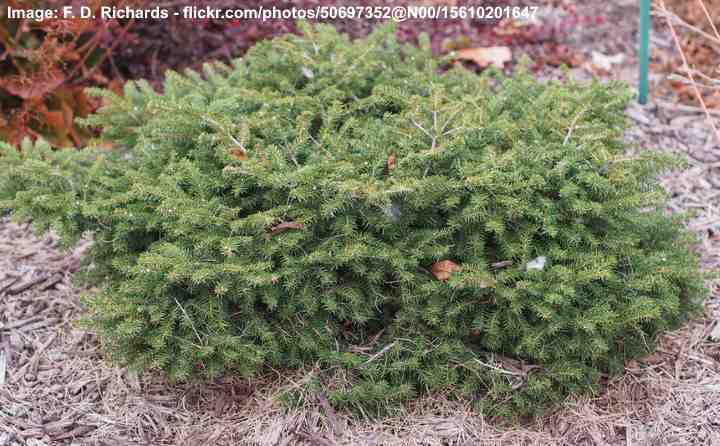
Bird’s nest spruce is a slow grower dwarf coniferous evergreen shrub for sunny gardens
Bird’s nest spruce is a compact, slow-growing, evergreen shrub that thrives in day-long sunshine. This ornamental shrub has a distinctive broadly round shape with a central depression, resembling a bird’s nest. The shrub’s dense, bright green foliage of needle-like leaves grows in a neat, symmetrical habit, making it an excellent landscaping choice.
Bird’s nest spruce grows 3 to 4 ft. (1 – 1.2 m) tall and a spread of 6 to 8 ft. (1.8 – 2.4 m). The evergreen conifer spruce shrub thrives in full sun and moist, well-drained soil. Landscaping uses for the shrub include low-growing ground cover or planting in rock gardens, sunny borders, and edges.
This low-maintenance shrub is suitable for growing in USDA zones 3 to 8.
Inkberry Holly (Ilex glabra)
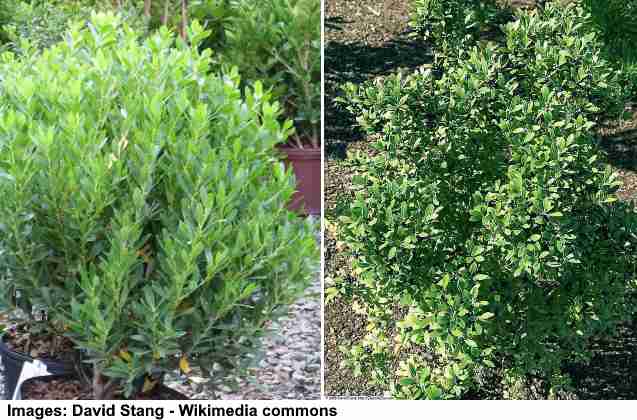
In the picture: Inkberry holly compact cultivars ‘Shamrock’ and ‘Pretty Girl’
Inkberry holly is a slow-growing evergreen shrub that thrives in six to eight hours of sunlight daily. Characteristic features of the shrubs are its glossy, dark green leaves and clusters of small white flowers followed by black berries. Thanks to its year-long appeal, inkberry holly is a popular landscaping choice for sun-filled gardens.
Inkberry holly grows 5 to 10 ft. (1.5 – 3 m) tall and wide. The holly shrub is ideal for planting as a hedge, foundation plant, windbreak, privacy screen, or specimen plant. The shrub is low-maintenance and drought-tolerant once established.
Inkberry holly is suitable for growing in USDA zones 4 through 11 in well-drained soil.
Carolina Cherry Laurel (Prunus caroliniana)
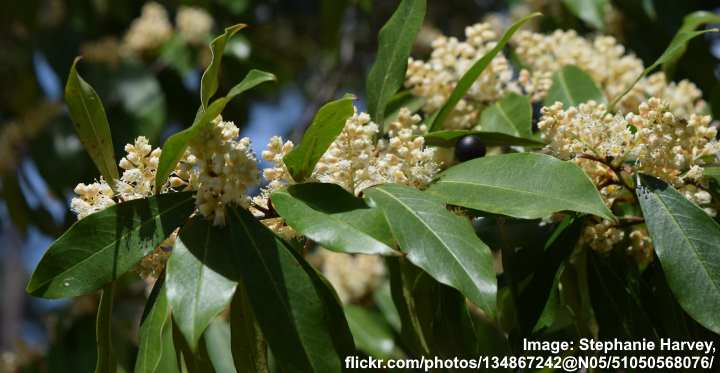
Carolina cherry laurel is a great choice for evergreen hedges or privacy living fence in sunny yards
Carolina cherry laurel is an evergreen shrub native to the Eastern United States. The sun-loving shrub has a pyramidal habit, glossy, dark green leaves, and fragrant white flowers. Fuzzy flower clusters bloom in spring, followed by small black berries. These berries are toxic to humans but serve as food for wildlife.
Carolina cherry-laurel shrub grows 10 to 20 ft. (3– 6 m) tall in its shrub form. Its dense evergreen attractive foliage and heat tolerance make it ideal for growing as a hedge, windbreak, or privacy screen in warm climates. The shrub also tolerates salt spray, meaning you can plant it in coastal landscapes or beach gardens.
Carolina cherry laurel is suitable for growing in USDA zones 7 through 10.
Japanese Pieris (Pieris japonica)
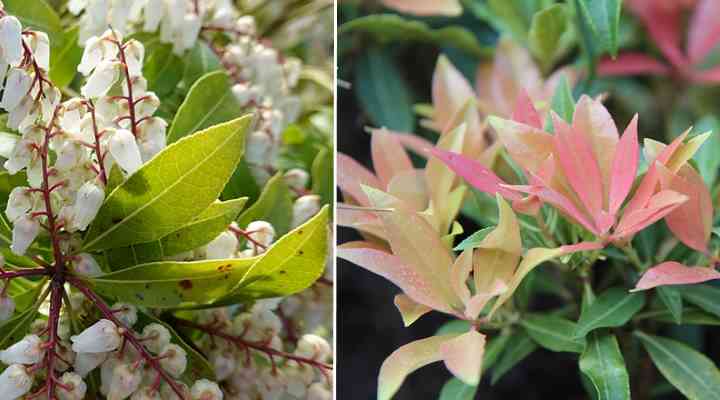
The pink-reddish young leaves of Japanese Andromeda evergreen shrub turn green when they mature
Japanese Pieris is a broadleaf evergreen shrub with striking clusters of delicate pink or white flowers. The plant’s glossy, dark green leaves provide a beautiful backdrop for the white flowers that droop in dangling clusters. The flowers bloom in early spring and last several weeks, making Japanese Pieris a popular choice for low-maintenance sunny front or backyards.
Japanese Pieris grows 9 to 12 ft. (2.7 – 3.6 m) tall and 8 ft. (2.4 m) wide. The plant is ideal for planting in direct sunlight as a foundation planting, to add texture and a splash of color to landscapes, or to create shrub borders.
Japanese Pieris is suitable for growing in USDA zones 5 through 8 in full sun or partial shade.
Indian Hawthorn (Rhaphiolepis indica)
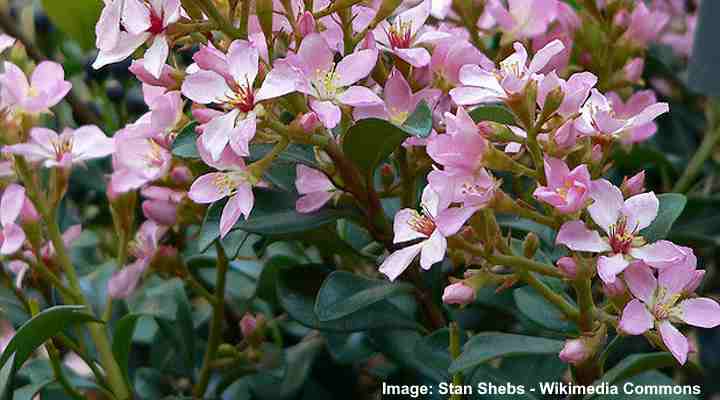
Indian hawthorn is an evergreen full-sun flowering shrub with pink or white flowers. This image shows Rhaphiolepis indica cv. ‘Ballerina’
Indian hawthorn is a full sun evergreen shrub with a rounded growth habit and masses of pink or white flowers. The beautiful clusters of flowers bloom in the spring. These blooms contrast nicely with the shrub’s thick, glossy leaves that remain on the plant year-round. The showy pink, fragrant flowers attract pollinators to the garden.
Indian hawthorn grows 4 to 6 ft. (1.2 – 1.8 m) tall and wide. Indian hawthorn in a row can create a beautiful hedge or screen, foundation planting, or add color and texture to perennial beds and borders. The low-maintenance shrub is also heat and drought-tolerant.
Indian hawthorn is suitable for planting in USDA zones 8 through 11.
Arborvitae (Thuja occidentalis)
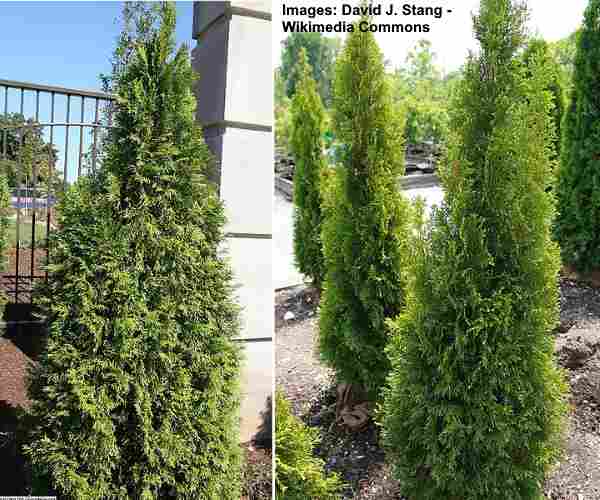
Pictures of thuja ’emerald green’ (‘Smaragd’) – it’s considered as one of the best evergreen shrubs for privacy hedge
Arborvitae is a group of evergreen coniferous shrubs and trees ideal for privacy screening and hedges. Thriving in plenty of sunshine, evergreen arborvitae shrubs have dense foliage that grows in a conical or rounded shape. The foliage is soft and feathery, and the tree produces small brown cones.
Small arborvitae shrubs grow 2 to 15 ft. (0.6 – 4.5 m) tall, depending on the variety. Thriving in full sun and well-draining soil, arborvitae shrubs have several uses in a sunny garden. Landscaping ideas for Thuja shrubs include a privacy hedge, windbreak, and accent plant. Smaller sun-loving shrubs perform well in containers to grow on balconies, patios, or accent an entranceway.
Arborvitae shrubs are suitable for growing in USDA zones 3 to 7. Some arborvitae dwarf varieties of coniferous shrubs can be under 2 feet (0.6 m) tall.
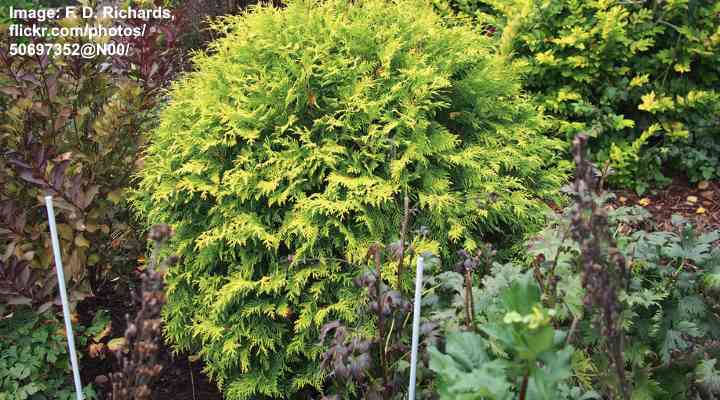
Thuja occidentalis ‘Aurea nana’ is a decorative sun-loving globe-shaped dwarf arborvitae with golden green foliage
Bottlebrush (Callistemon)
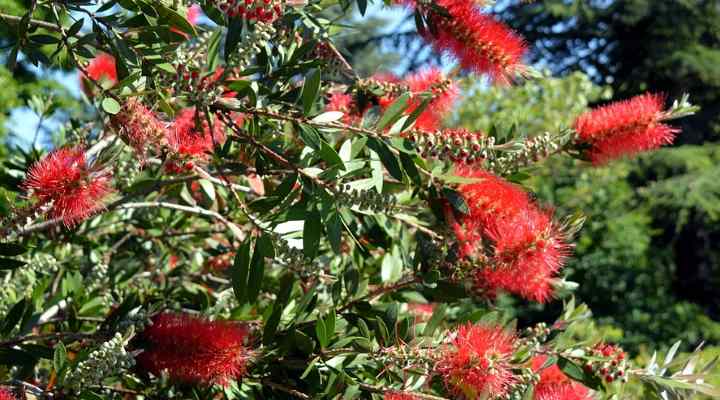
Bottlebrush is a tropical evergreen red flowering shrub that can be used as a hedge plant in sunny spots
Bottlebrush shrubs are sun-loving bushy plants with spectacular red bottlebrush-like flowers. Blooming in spring, the fuzzy cylindrical flowers are made up of long, slender filaments resembling brush bristles. The small shrub has narrow, evergreen leaves, and it can grow 4 to 10 ft. (1.2 – 3 m) tall and wide.
Bottlebrush shrubs are ideal for planting in sunny, well-drained locations. The attractive arching floral spikes attract pollinators like bees and butterflies to the garden. The red-flowering shrub creates a focal point in a sunny garden or performs well as a hedge plant or mixed border shrub.
Varieties like the weeping bottlebrush (Callistemon viminalis) and dwarf bottlebrush (Callistemon citrinus ‘Little John’) are perfect for sunny spots in smaller gardens.
Bottlebrush is suitable for growing in USDA zones 8 to 11.
Cape Jasmine (Gardenia jasminoides)
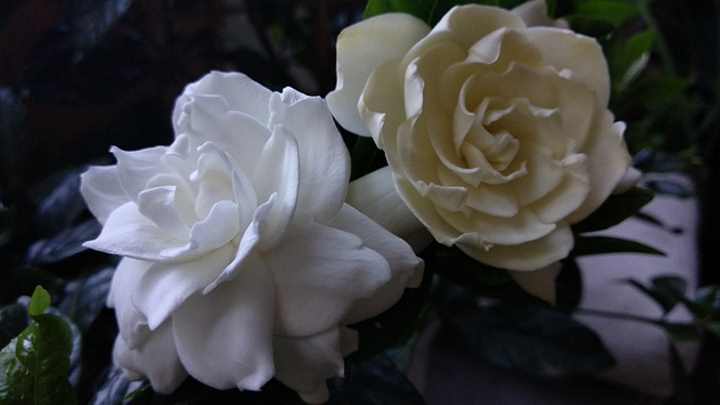
The white flowers of the evergreen cape jasmine bush add beauty and fragrance to a sunny garden
Cape jasmine, also known as gardenia, is a group of beautiful sun loving evergreen bushes. They feature showy, fragrant white flowers that bloom throughout the summer. Cape jasmine fills sunny landscapes with sweet-smelling fragrances and lush, evergreen foliage. The white flowers of this shrub have a waxy texture and can appear as double blooms with ruffled petals or single star-shaped blooms.
Cape jasmine shrubs generally grow up to 3 to 5 ft. (1 – 1.5 m) tall and wide. However, some varieties of evergreen gardenia shrubs are shorter, not exceeding 2 feet. The best flowering happens in full sun, but they tolerate partial shade. Gardenia can be used as a specimen plant, hedge, or in containers for landscaping ideas.
Cape jasmine is suitable for growing in USDA zones 8 to 11.
Evergreen Camellia Shrubs for Sun
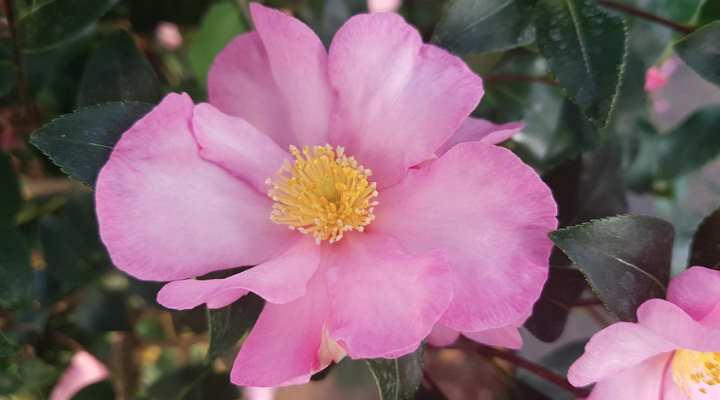
Camellia sasanqua are beautiful flowering evergreen shrubs for both sunny and shaded locations with various cultivars including dwarf shrubs
Camellia shrubs are known for their beautiful, showy flowers in shades of pink, red and white. Camellia shrubs also have lustrous glossy, evergreen leaves. While most camellias prefer partial shade, shrubs in the Camellia sasanqua group thrive in bright sunshine and full shade.
Camellia sasanqua shrubs bloom in fall and winter with showy, fragrant flowers consisting of ruffled or wrinkled petals. Perfect for adding a splash of color in a sunny spot, sun-hardy camellia shrubs are ideal specimen plants, hedges, privacy screens, or foundation plantings. They require well-drained soil and regular watering in the growing season.
Sasanqua camellia is suitable for growing in USDA zones 7 to 9 in full sun to deep shade.
Evergreen Daphne Shrubs
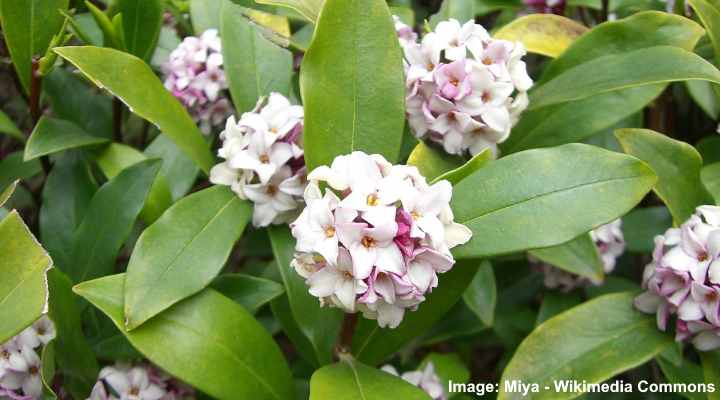
Daphne odora (common daphne) is an evergreen shrub with fragrant blossoms for full sun or partial shade
Evergreen daphne shrubs are perfect for planting in exposed gardens with constant sunshine. These ornamental shrubs are known for their clusters of fragrant tubular flowers in pink, yellow, red, magenta, and purple shades. Additionally, the shrub has lush foliage that remains on the attractive shrub all year long.
Some varieties of daphne shrubs don’t grow taller than 2 feet (0.6 m). However, most evergreen daphne shrubs grow 3 to 5 ft. (1 – 1.5 m) tall. The sun-tolerant shrubs perform well in sunny spots in mixed borders, along a foundation line, or as specimen plants.
Daphne shrubs are also deer-resistant and attract pollinators to summer gardens. They are suitable for growing in USDA zones 4 to 9.
Flowering Maple (Abutilon pictum)
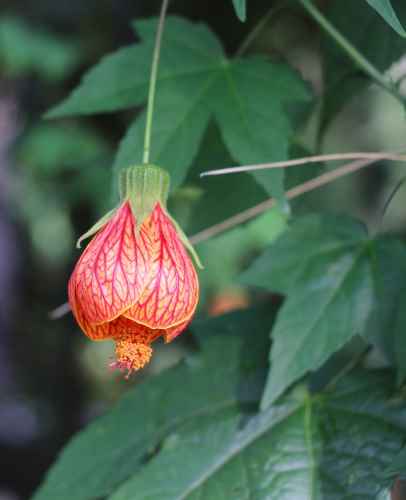
Flowering maple evergreen shrub grows best in full sun and produces attractive orange flowers with prominent red veins
Flowering maple is a popular evergreen shrub for landscaping sunny yards. The vigorous sun-loving shrub produces salmon-orange bell-shaped flowers in showy clusters. The papery orange-red flowers bloom from spring until fall, and the evergreen leaves add to their ornamental value. The flowering maple grows up to 6 to 10 ft. (1.8 – 3 m) tall and wide.
Flowering maple is perfect for planting where it gets lots of sun to flower. The evergreen shrub works well in a sunny garden as an accent plant, hedge, specimen shrub, or container plant. The shrub also attracts hummingbirds and butterflies to the garden.
Flowering maple is suitable for growing in USDA zones 8 through 10.
Chinese Fringe Flower (Loropetalum chinense)
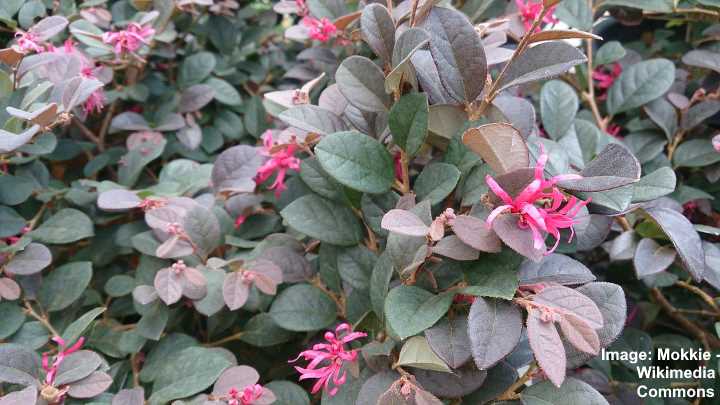
The compact sun-loving Chinese fringe flower shrub has colorful evergreen foliage and deep pink flowers
Chinese fringe flower is a compact evergreen shrub that flowers profusely when drenched in sunshine. Ornamental features of the long-blooming shrub are clusters of vibrant deep pink spidery flowers and dark, evergreen burgundy leaves. Its purple-red foliage and brightly colored flowers that bloom throughout the summer add a dramatic, colorful display to sunny landscapes. The fringe flowers bloom in early spring and can last until fall.
The Chinese fringe flower shrub grows 5 to 6 ft. (1.5 – 1.8 m) tall and wide and thrives in full sun or partial shade. The decorative shrub is extremely versatile for sunny gardens. It performs well as a hedge, foundation planting, screening, or growing in containers.
Chinese Fringe Flowers are suitable for planting in USDA zones 7 to 9.
Evergreen Viburnum Shrubs
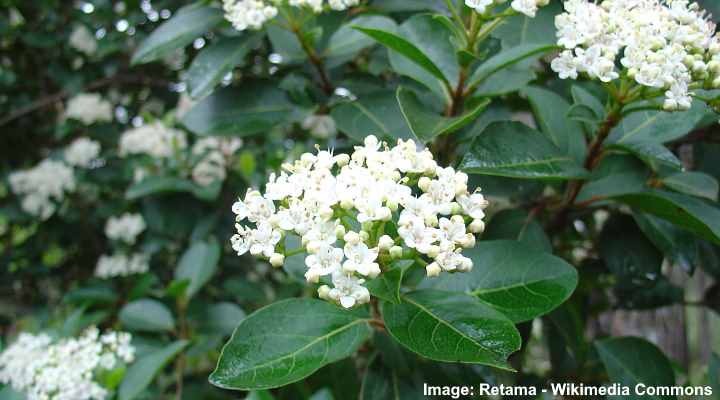
In the picture: Viburnum tinus shrub with a dense, rounded growth habit and evergreen foliage
Evergreen viburnum shrubs are perfect for planting in sunny spots in a front or backyard. The bushy shrubs bloom in spring and summer with flat-topped clusters of small, five-petaled star-shaped flowers. The shrubs retain year-round interest with their glossy green foliage, showy blooms, and colorful berries in the summer and fall.
Viburnum shrubs with evergreen foliage grow 6 to 10 ft. (1.8 – 3 m) tall and wide. Their dense, evergreen foliage and attractive shape make the shrubs ideal for hedges, privacy screens, shrub borders, or foundation planting. The evergreen shrubs are ideal for sun-drenched gardens and are easy to grow in acidic soil and full sun.
Varieties of evergreen viburnum shrubs include the following:
- Viburnum tinus
- Viburnum x burkwoodii
- Viburnum japonicum
Scarlet Firethorn (Pyracantha coccinea)

Scarlet firethorn is an evergreen shrub with white flowers and red berries for full sun to part shade
Scarlet firethorn is a sun-loving evergreen shrub with white flowers and colorful berries growing on thorny branches. The woody shrub blooms in early spring with masses of small white flowers. The spiny branches have small, oval leaves. In the fall, red-orange or bright red berries appear and persist into winter.
The scarlet firethorn shrub grows 6 to 12 ft. (1.8 – 3.6 m) tall and wide. Its thorn-covered branches and dense growth habit make it an impenetrable screen or hedge. It can also grow as a wall-side border, foundation planting, or shrub border.
Scarlet firethorn is suitable for growing in USDA zones 6 to 9.
Related articles:
